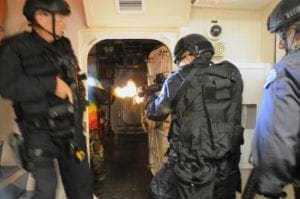Counter-Terrorism ‘Experts’ Failed to Identify Threat Prior to San Bernardino Attack
This article was featured in our weekly newsletter, the Liberator Online. To receive it in your inbox, sign up here.
The deadly San Bernardino attack prompted everyone from presidential candidates to media personalities to focus on the threat of Islamic radicals committing terrorist attacks at home. But in their quest to focus only on the religion as the root of terrorism here and abroad, many ignored the fact that both San Bernardino and Riverside counties held the First Annual Inland Terrorism Liaison Officer Conference just weeks before the San Bernardino shooters killed 14 people and injured other 22.
The region, The Intercept’s Jana Winter argues, has become home to a hub of counter-terrorism training groups, where countless people are taught to identify would-be terrorists before they actually put their plans into action.

Law enforcement, public officials, and several members of the private sector have access to these trainings. Yet nobody was able to identify the two attackers in time to avoid bloodshed.
As Syed Rizwan Farook and Tashfeen Malik planned to carry their attack, locals who were part of these trainings just 25 miles from where the attacks took place were unable to identify what experts call “behavioral indicators” of potential terrorists. Such indicators are a central part of the US counter-terrorism prevention strategy.
According to Michael German, a former FBI agent who’s now a fellow at the Brennan Center for Justice at New York University School of Law, behavioral indicators used by law enforcement to fight terrorism rely “on generalized correlations found in selectively chosen terrorists without using control groups to see how often the correlated behaviors identified occur in the non-terrorist population.” To the former FBI agent, the theories that back the counter-terrorism trainings are flawed:
“The FBI, [National Counter-Terrorism Center], and [Department of Homeland Security] promote these theories despite the fact they have been refuted in numerous academic studies over the past 20 years.”
Even as groups debunk the US counter-terrorism effort to use behavioral indicators to identify potential terrorists, the industry is and has been blooming in California in recent years.
The Joint Regional Intelligence Center, which is a Los Angeles chapter of InfraGard (an FBI-backed group), is known for having produced dozens of Official Use Only intelligence bulletins that focus solely on behavior indicators.
In 2002, California hosted the first Terrorism Liaison Officer program, an initiative that enlists community members and representatives of the private sector to be the eyes and ears of the counter-terrorism community nationwide. While the program was first launched out of the Los Angeles chapter of InfraGard, it has been since expanded to the entire nation.
In 2013, the Los Angeles County Board of Supervisors renewed its contract with InfraGard’s LA chapter by signing a new $2,530,000 deal with the group, which was later extended through 2018. CT Watch, one of the companies hired by InfraGard to conduct counter-terrorism trainings, is famous for its “Threat of ISIS and radicalization in the homeland” seminar. CT Watch’s director, Roque “Rocky” Wicker, says that behavior indicators work, “you just need to train the right people.”
Other training sessions held recently in Riverside include “The Stealth Jihad in the United States,” “How to assess the threat posed by a potential lone wolf attacker,” and “Behavior threat assessment: preventing the Active Shooter.” All of these sessions took place on October 22, a few weeks before the December attack in San Bernardino.
Despite California’s long lasting relationship with the counter-terrorism effort, none of the well-trained officers or community members in the region were able to identify the terrorists operating from San Bernardino.
Should we, as Americans, allow the government to continue using the same failed tactics to keep us safe? Better yet, should we allow our tax dollars to go to groups that claim to know what they are doing, even as they fail to contain potential threats at home repeatedly?
These are some of the tough questions we should be asking our presidential candidates this year.

























